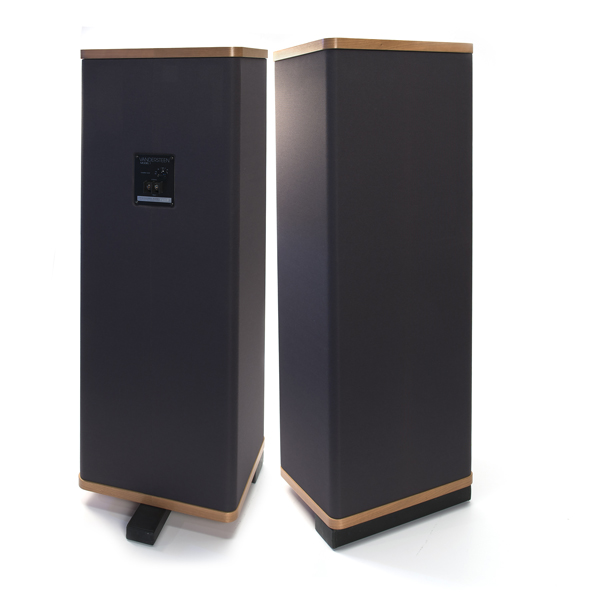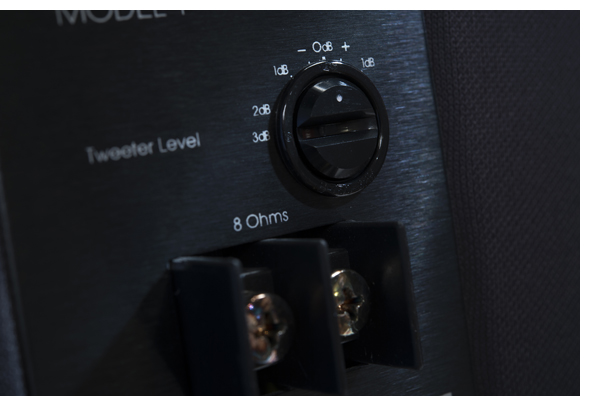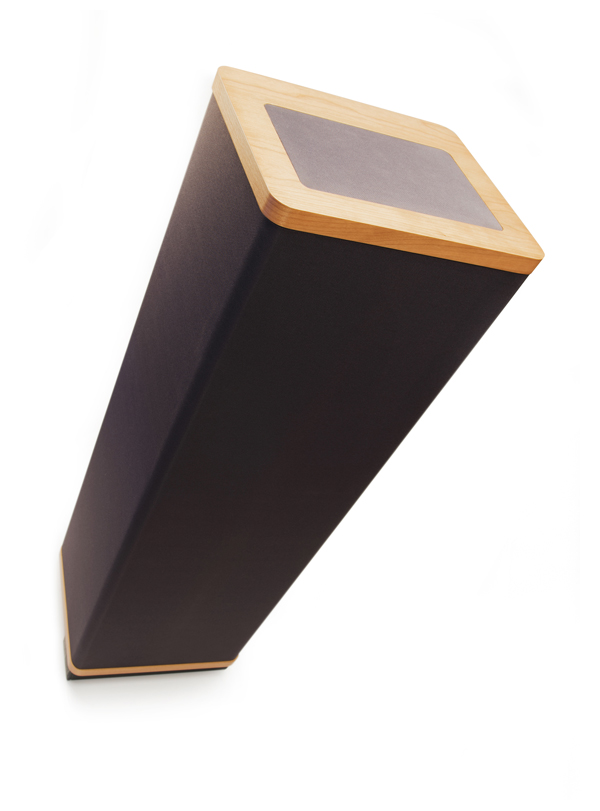Listening to the Beatles’ “All You Need is Love,” I’m thinking that you also need a great hi-fi system. (And a cool car, but I digress.) Fortunately, a pair of Vandersteen 1Ci speakers and some decent electronics can be had for a reasonable cost, putting a great system in reach of just about anyone: $1,149 for a pair of full-range floorstanding speakers is a steal in today’s hi-fi world, where you could pay 10 times that for a pair of interconnects.
Vandersteen’s higher-priced Model 2 speaker is quite possibly high-end audio’s all-time most popular speaker, with almost 100,000 pairs sold. That’s a major achievement in the context of some of today’s speaker manufacturers, many of which haven’t even sold 1,000 pairs. And if the Model 2 isn’t the most popular, it certainly has the most longevity, having been produced since the late 1970s – now at 2CE Signature II status.
While the 2 has gotten much of the spotlight, I submit that the Model 1—now the 1Ci—is the way to roll for so many reasons, the main one being its 90-dB sensitivity. Sure, the 2’s three-way design delivers deeper bass, but the simplicity of a two-way speaker has always been highly appealing to me. And that extra 3 dB of efficiency makes a much wider range of amplification choices possible. Unlike another great American speaker, the Magnepan, the Vandersteen 1Ci comes alive with 25 to 35 watts of clean power, making it the perfect choice for the music lover on a modest budget.
What the 1Ci offers perhaps better than any other speaker at its price point is balance. Everyone at TONEAudio is convinced of the brilliance of the KEF LS50, and while that speaker delivers more holographic imaging and ultimately more resolution than the 1Ci can muster, it lacks on the bottom-end, and requires a fairly powerful amplifier to deliver its best performance. For someone listening in a smaller room, or a closer field situation, the diminutive Brit speaker is still the one to beat on a tight budget, but if you have a larger room or prefer a fuller-spectrum frequency response, the 1Ci is the ticket.
Best of all, the 1Ci is resolving enough to make it easy to discern amplifier differences, so if you fall in love with a pair early in your system’s history, they will probably be the last component you upgrade. I know more than one audiophile who has progressed from the Model 1 all the way up to Model 5, as well as a few using 1C’s with some fairly expensive electronics.
Cliché but True
If there was ever a speaker that fit the definition of “greater than the sum of its parts,” the Vandersteen 1Ci is it. Richard Vandersteen has always believed in putting the money into high-quality drivers and crossover components rather than the cabinetry. Back in the late ’70s when Vandersteen hit the scene, his approach was revolutionary. Where so many of the major manufacturers were putting so much money into speaker cabinets, Vandersteen took a performance-first approach with the Model 1 and 2, concentrating on the internals, with a first-order crossover, minimum front baffle, and time-aligned design.
The results are stunning, and while other speakers have come in and out of fashion, Vandersteen audio keeps making solid, musically accurate speakers that don’t break the bank. The 1Ci features improvements to the dome tweeter and crossover network, along with eliminating the banana jacks on the rear panel, now using the same screw terminals as those featured on the Model 2. Interestingly, these terminals connect directly to the crossover network, eliminating the need to use premium wire—again, simplicity rules the day. While a tweeter contour (level) control is provided, the speakers perform best in the middle position in all three of my listening rooms. Should you need to slightly modify the tweeter output level, the control offers a 2-dB boost or cut, which is highly effective.
The Rake is the Key
To the company’s credit, Vandersteen provides one of the best instruction manuals in the industry. It takes even a complete novice through the finer points of speaker setup. Starting with the “thirds” method that has always served me well with Vandersteens over the years, I have the 1Ci speakers singing in my 11-by-13-foot room in no time at all, with just a few fine adjustments.
Vandersteen speakers have occasionally received a bad rap on various Internet forums for being “slow and dark” sounding. If this has been your experience with any Vandersteen speakers, it’s because they were improperly set up. Because of the speakers’ time alignment, getting the proper rake angle is critical. Every pair of MartinLogan speakers I’ve owned requires the same care. Get it right, and the speakers disappear in the room. Get it wrong and everything sounds a bit muffled—much like when you finally nail proper VTA with your phono cartridge.
Again, the manual gives you the perfect method to optimize this, and Vandersteen has done the work for you. Follow the guidelines in the manual, starting with its suggestions, and then alter the rake ever so slightly to fine tune. (and I’m talking less than an inch here) Having a friend help you will make the process go much quicker, and it is critical that you match the angle as closely as you can on each speaker. Five extra minutes spent here will reward you with a larger stereo image and an airier, more extended treble.
Richard Vandersteen is quick to point out that with some other speakers, adjusting the rake angle will tame a hot tweeter, but it is critical with his speakers to follow the setup parameters as the listening height and distance from speaker to listener coalesce for flat frequency response, at the specified point.
How Do You Want to Play?
These speakers totally rock, providing a high level of musical involvement. Regardless of the amplifier you choose, the 1Ci speakers throw a big and well-defined soundstage into the listening room. Thanks to the speakers’ natural character, your choice of amplification will let you easily tailor the sound to your liking.
I use four different amplification setups during of this review: A new old-stock Sansui 771 vintage solid-state receiver ($299); the Rega Brio-R solid-state integrated amplifier ($995, our 2010 Product of the Year); a factory-refurbished Conrad-Johnson MV50 vacuum tube power amplifier and matching PV-12 vacuum tube preamplifer (about $2,500 the pair); and the Devialet 110 DAC/streamer/integrated ($6,400).
The 1Ci speakers not only work flawlessly with each combination, they also easily resolve the nuances between each amplification type. If you prefer things more on the warm and romantic side, the easy load that these speakers present is a perfect match for your favorite tube amplifier. Even my 25-watt 845 SET monoblocks drive the Vandersteens with ease, offering an enveloping sound that, while the least accurate of anything else in my arsenal, proves highly seductive.
Spinning some vintage and remastered Blue Note selections is pure heaven. Drums explode from the 1Ci speakers, with a soundstage that not only feels beyond the speaker boundaries, but also beyond the boundaries of my modest listening room. Listening to acoustic instruments and, of course, solo vocals through vacuum-tube electronics and the 1Ci speakers easily convinces non-audiophile and audiophile alike that these speakers are indeed something special.
With 110 watts per channel of hybrid power, the Devialet 110 offers presentation that is 180-degrees different from those of the SET monoblocks. While the Devialet renders a more accurate presentation, the sheer grip of its Class-A/Class-D hybrid design provides a major low-frequency extension and control that the vacuum tubes cannot. Mickey Hart’s “The Eliminators” is full and deep, with forceful bass notes that punch you in the stomach—and the 1Ci speakers capture this wonderfully with the Devialet. Kraftwerk’s classic “Autobahn” also brings a big thumbs up from an informal listening panel, who are all amazed what could be accomplished with such a modestly priced yet well-executed speaker system.
No Wrong Moves
Stereophile once said about the Model 2 that “the only sins this speaker commits are ones of omission,” and 20-plus years later, the same description applies to the 1Ci. It offers a highly neutral tonal balance, wide dynamic range and a full frequency response—for $1,200 a pair! They nail the musical fundamentals better than some speakers I’ve heard that cost 20 times as much.
After living with the 1Ci speakers for a couple of months, I’m buying them—they are a fantastic reference for what can be accomplished on a tight budget. And they’re great speakers to use as a building block when auditioning ancillary components in the $1,000-to-$3,000 range.
We are very pleased to award the Vandersteen 1Ci one of our Exceptional Value Awards for 2014. These speakers are so enjoyable that, if your high-end journey stopped right here, you’d be a pretty happy human being. Even if you are a highly experienced audiophile and you haven’t heard these, you owe it to yourself to check them out. I guarantee you’ll be very surprised for the better. They redefine what is possible for a modest price.
The Vandersteen 1Ci speaker
$1,149/pair
PERIPHERALS:
| Digital source | Meridian MS200 AURALiC Vega DAC |
| Analog source | AVID Ingenium TT SME 309 arm Lyra Delos cartridge |
| Phono stage | ARC PH8 |
| Cable | Cardas Clear |

















